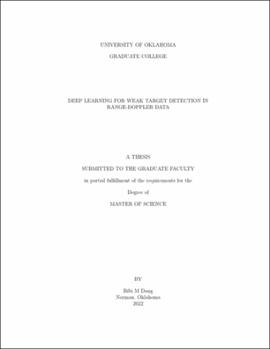| dc.contributor.advisor | Hougen, Dean | |
| dc.contributor.author | Dang, Bibi | |
| dc.date.accessioned | 2022-05-05T21:35:40Z | |
| dc.date.available | 2022-05-05T21:35:40Z | |
| dc.date.issued | 2022-05 | |
| dc.identifier.uri | https://hdl.handle.net/11244/335555 | |
| dc.description.abstract | A consistent issue for detectors in radar systems is how to correctly distinguish target signals from random noise. This is especially true for weak targets with low signal-to-noise ratios (SNRs). Traditional target detection techniques, such as constant false alarm rate (CFAR) detectors, apply detection thresholds that must be set to maximize the probability of detection (PD) while minimizing the probability of false alarm (PFA). These traditional detection techniques also struggle with increasing levels of computational complexity in low-SNR environments. This work investigates the application of deep neural networks towards the radar target detection problem. Two neural network architectures, NoisyLSTM and U-Net, are tested on range-Doppler data to identify regions of interest in which targets may be present. The U-Net model demonstrates promising results, producing detection predictions with a PD of 0.97 and PFA of 0.01 for targets captured by a staring radar at 10dB input SNR. This deep learning architecture may serve as a valuable preprocessing step to reduce the search space of more sophisticated radar detectors. | en_US |
| dc.language | en_US | en_US |
| dc.subject | Machine Learning | en_US |
| dc.subject | Deep Learning | en_US |
| dc.subject | Radar | en_US |
| dc.subject | Target Detection | en_US |
| dc.title | Deep Learning for Weak Target Detection in Range-Doppler Data | en_US |
| dc.contributor.committeeMember | Metcalf, Justin | |
| dc.contributor.committeeMember | Diochnos, Dimitrios | |
| dc.date.manuscript | 2022-05 | |
| dc.thesis.degree | Master of Science | en_US |
| ou.group | Gallogly College of Engineering::School of Computer Science | en_US |
